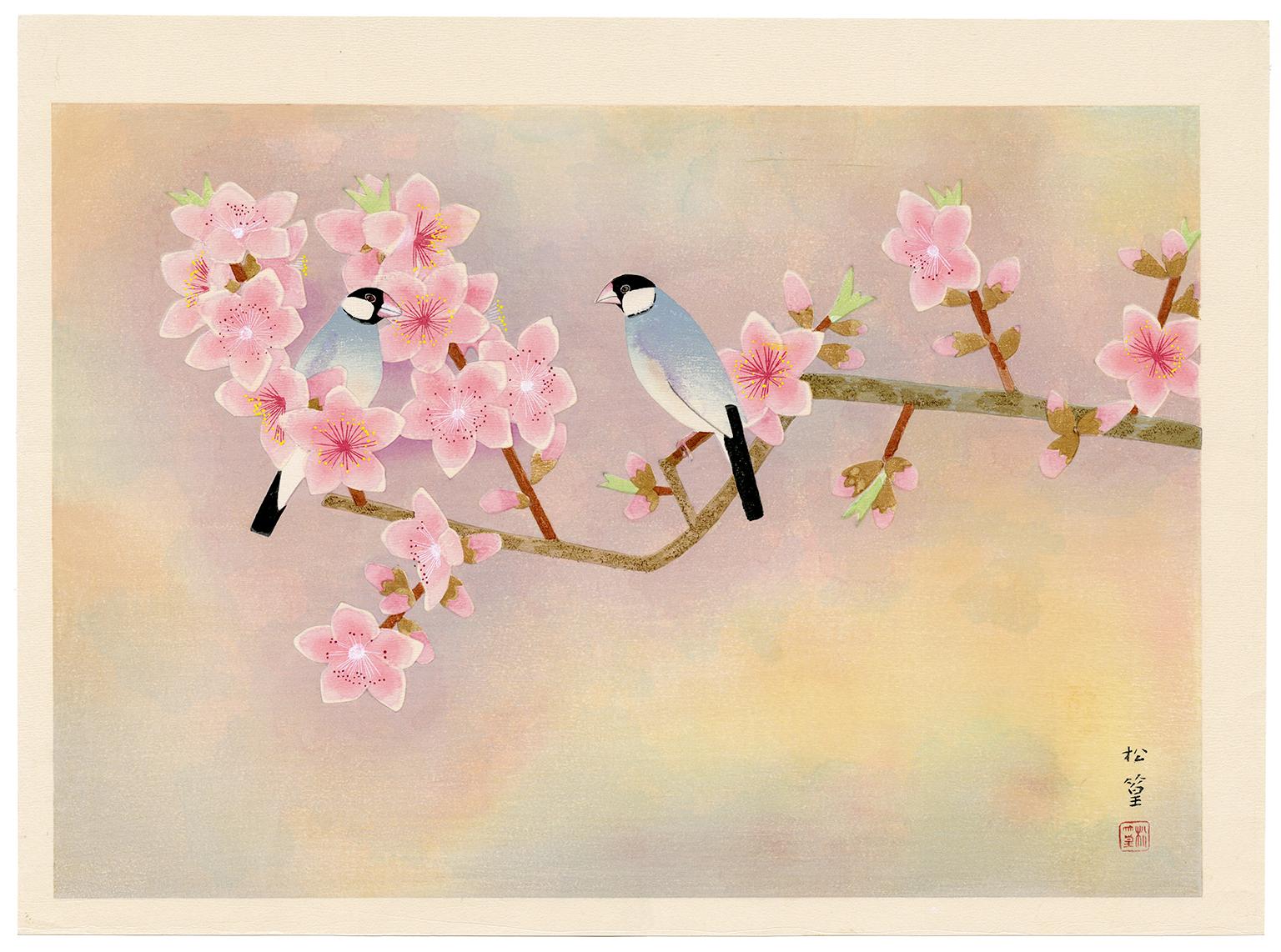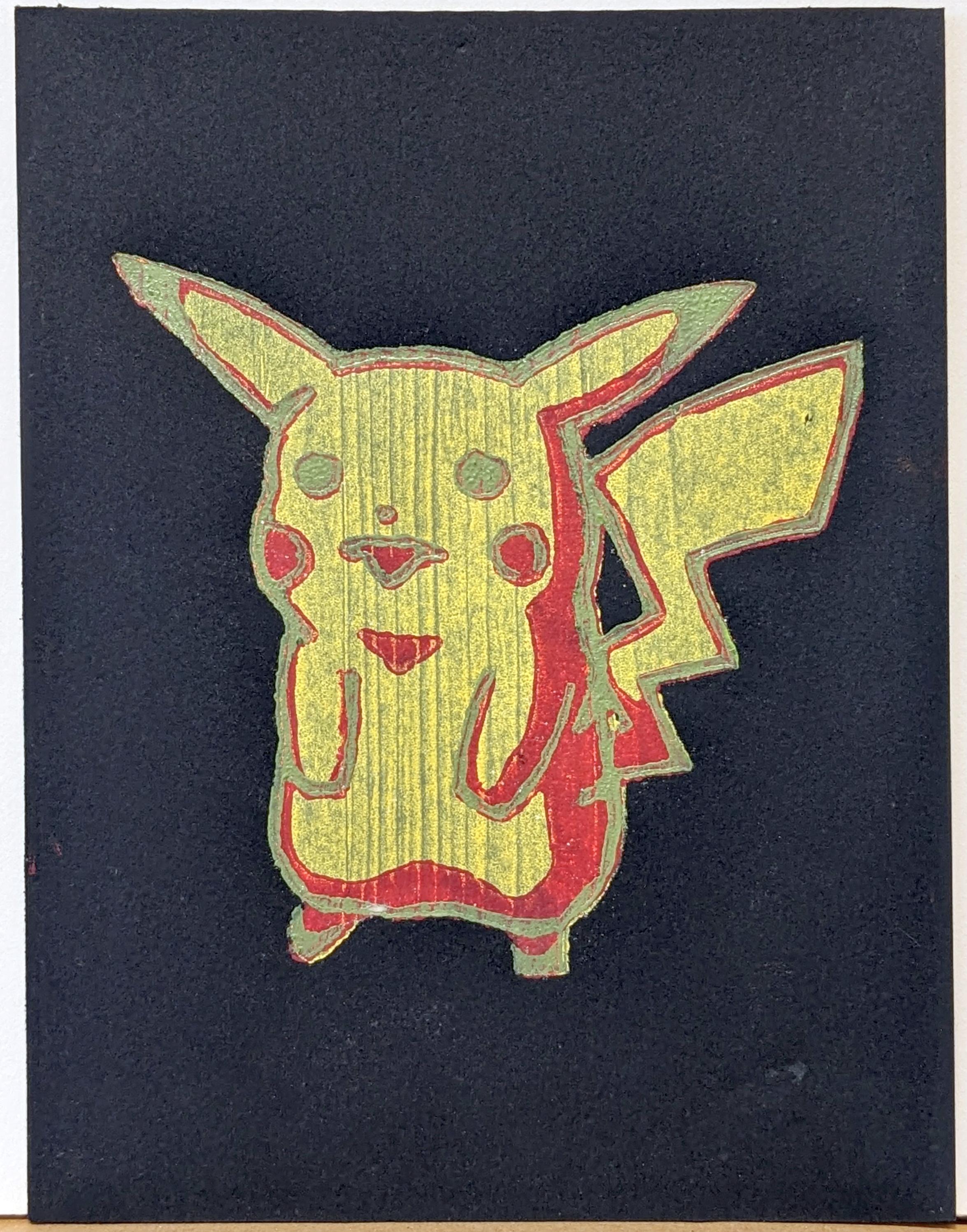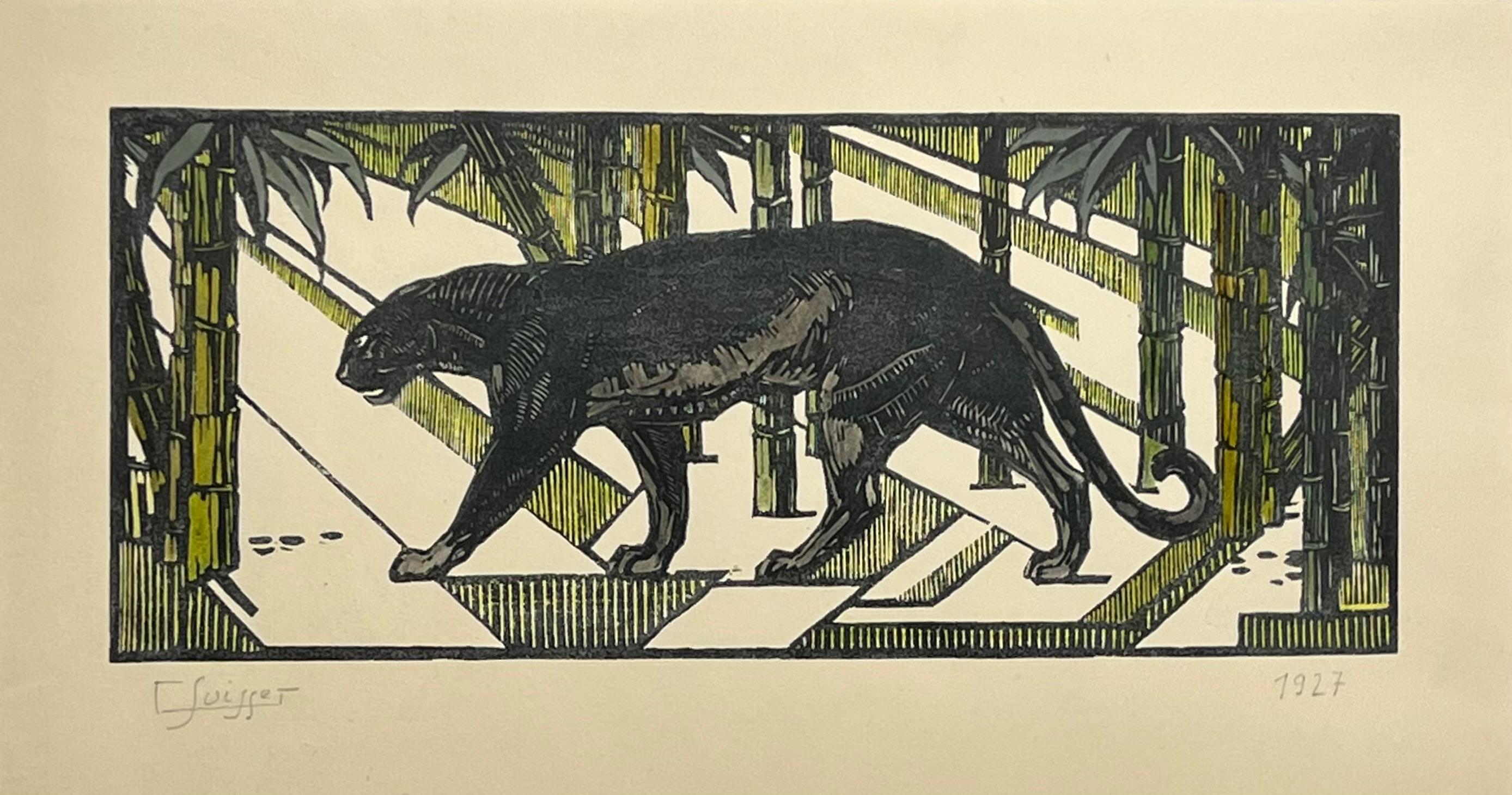Items Similar to 'Carp and Water Chestnut' — Showa lifetime impression
Want more images or videos?
Request additional images or videos from the seller
1 of 3
Ohara Koson'Carp and Water Chestnut' — Showa lifetime impression1926
1926
About the Item
Ohara Koson (1877-1945), 'Carp and Water Chestnut', color woodblock print, 1926. A fine impression, with fresh colors, on cream Japan paper; the full sheet, in excellent condition.
Signed 'Koson' with the artist’s red seal 'Koson'. Published by Watanabe Shozaburo. With the Watanabe 'C' seal in the lower right margin, indicating a lifetime impression printed between 1929-1942.
Image size 13 1/2 x 7 1/4 inches (343 x 184 mm); sheet size 14 1/2 x 7 1/2 inches (368 x 191 mm). Archivally sleeved, unmatted.
Literature: 'Crows, Cranes, and Camellias: The Natural World of Ohara Koson', Newland, Amy R.: Jan Perree & Robert Schaap, Leiden: Hotei Publishing, 2001. S39.1, pl 169.
Collections: National Museum of Asian Art (Smithsonian), Smart Museum of Chicago (University of Chicago).
In Japanese art, the carp represents good luck and good fortune.
ABOUT THE ARTIST
Koson Ohara (also Shoson and Hoson, 1877-1945) is the most renowned Japanese artist of early 20th-century kacho-e (bird-and-flower pictures) woodblock printmaking. With meticulous detail, sensitive color, and a palpable reverence for flora and fauna, Koson brought the genre into the modern era.
Koson was born in Kanazawa with the given name Matao Ohara. He began his artistic career studying painting under the Shijo-style master Kason. Around the turn of the century, Koson became a teacher at the Tokyo School of Fine Arts, where he met Ernest Fenollosa, an American collector, scholar, and admirer of Japanese art and culture. Around 1905, Koson started to produce woodblock prints. Fenollosa, the curator of Japanese Art at the Museum of Fine Arts, Boston, and an adviser to the National Museum of Modern Art in Tokyo, persuaded Koson to export his bird prints to American art collectors.
Between 1900 and 1912, Koson worked with several different publishers and designed a series of Russo-Japanese War prints, as well as genre landscapes, but his passion remained with kacho-e. His earliest and rarest designs are notable for their narrow formats and soft colors. All his woodblock prints were signed or sealed Koson—most of them published by Kokkeido and Daikokuya. After 1912, he changed his name to Shoson and dedicated himself to painting.
Ten years later, Koson returned to printmaking, and in 1926, he began designing woodblock prints for the esteemed Shin Hanga publisher Shozaburo Watanabe. Koson changed his name once again, this time to Hoson, when he produced designs collaboratively published by Sakai and Kawaguchi around 1930. He also served as an adviser to the National Museum of Modern Art in Tokyo.
Koson’s prints can be found in many major museums worldwide, including the British Museum, Brooklyn Museum, Freer Gallery, Harvard Art Museums, LACMA collections, Museum of Fine Arts, Boston, and the Metropolitan Museum of Art.
- Creator:Ohara Koson (1877 - 1945, Japanese)
- Creation Year:1926
- Dimensions:Height: 13.5 in (34.29 cm)Width: 9.25 in (23.5 cm)
- Medium:
- Movement & Style:
- Period:
- Condition:
- Gallery Location:Myrtle Beach, SC
- Reference Number:
About the Seller
5.0
Recognized Seller
These prestigious sellers are industry leaders and represent the highest echelon for item quality and design.
Platinum Seller
These expertly vetted sellers are 1stDibs' most experienced sellers and are rated highest by our customers.
Established in 1995
1stDibs seller since 2016
254 sales on 1stDibs
Typical response time: 2 hours
Associations
International Fine Print Dealers Association
- ShippingRetrieving quote...Ships From: Myrtle Beach, SC
- Return PolicyA return for this item may be initiated within 7 days of delivery.
More From This SellerView All
- Eagle on Snow Covered Pine — Showa Woodblock PrintBy Ohara KosonLocated in Myrtle Beach, SCOhara Koson (1877-1945), 'Eagle on Snow Covered Pine', color woodblock print, c. 1905. Signed 'Koson' with the artist’s red seal 'Koson'. A very fine impression, with fresh colors on cream Japan paper; embossing in the snow-laden branches and the falling snow rendered with hand-splashed ‘gofun.' The full sheet in excellent condition; stamped 'MADE IN JAPAN' lower left, verso. Published by Nishinomiya Yosaku; a pre-WWII impression. Image size 13 11/16 x 7 7/16 inches (348 x 189 mm); sheet size 14 1/2 x 8 1/8 inches (368 x 206 mm). Archivally sleeved, unmatted. Literature: 'Crows, Cranes, and Camellias: The Natural World of Ohara Koson', Newland, Amy R.: Jan Perree & Robert Schaap, Leiden: Hotei Publishing, 2001. pg. 86, pl. 67. ABOUT THE ARTIST Koson Ohara...Category
Early 1900s Showa Animal Prints
MaterialsWoodcut
- Inside the Flowers (Java Sparrow and Peach Blossoms) — Japanese Woodblock, 1950Located in Myrtle Beach, SCShoko Uemura, 'Inside the Flowers (Java Sparrow and Peach Blossoms)', color woodcut, c. 1950s, edition 300. Signed in ink with the artist’s red seal beneath. A fine impression, with ...Category
1950s Showa Animal Prints
MaterialsWoodcut
- 'Wading Egret' — Japanese Woodblock kacho-e, c. 1900By Ohara KosonLocated in Myrtle Beach, SC'Wading Egret', color woodblock, c. 1900 - 1910. Signed 'Koson' in black ink with the artist’s red seal beneath, lower left. A superb, skillfully-inked impression, with fresh colors,...Category
Early 1900s Naturalistic Animal Prints
MaterialsWoodcut
- 'Foul Rope (Left)' — early American rodeoBy William Robinson LeighLocated in Myrtle Beach, SCWilliam Robinson Leigh, 'Foul Rope (Left)', etching, c. 1920, edition unknown but small. Signed in pencil. Signed in the plate, lower left. A superb, richly-inked impression, in dark brown ink, on buff wove Umbria paper, the full sheet with margins (1 1/2 to 2 3/4 inches); slight toning at the sheet edges, otherwise in excellent condition. Very scarce. Image size 14 7/8 x 11 15/16 inches (378 x 303 mm); sheet size 20 3/8 x 15 3/8 inches (518 x 391 mm). Archivally matted to museum standards, unframed. ABOUT THE ARTIST Born near Falling Waters, West Virginia on a plantation a year after the Civil War, and raised in Baltimore, William Robinson Leigh (1866 - 1955) became one of the foremost painters of the American West. His career spanning some seventy-five years, Leigh created some of the most iconic depictions of the western landscape, admirers referring to him as ‘The Sagebrush Rembrandt’. The son of impoverished Southern aristocrats, Leigh took his first art training at age 14 from Hugh Newell at the Maryland Institute where he was regarded as the best student in his class. From 1883 to 1895, he studied in Europe, mainly at the Royal Academy in Munich with Ludwig Loefftz. From 1891 to 1896, he painted six cycloramas or murals in the round, a giant German panorama. In 1896, Leigh began working as a magazine illustrator in New York City for Scribner's and Collier's Weekly Magazine, and he also painted portraits, landscapes, and genre scenes. Leigh's trips to the Southwest began in 1906 when he made an agreement with William Simpson, Santa Fe Railway advertising manager, to paint the Grand Canyon in exchange for free transportation West. In 1907, he completed his Grand Canyon painting, which led to more commissions and an extensive painting trip through Arizona and New Mexico. These travels inspired him to paint western subjects for the next 50 years, his primary interest being the Hopi and Navajo Indians. In 1910, he traveled to Wyoming, where he painted in Yellowstone Park and created sketches, many of which he later converted into large canvases such as ‘Lower Falls of the Yellowstone’ (1915) and ‘Grand Canyon of the Yellowstone’ (1911). In 1926 he traveled to Africa at the invitation of Carl Akeley for the American Museum of Natural History, and from this experience wrote and illustrated 'Frontiers of Enchantment: An Artist's Adventures in Africa'. In 1933, he wrote and illustrated 'The Western Pony'. His adventures were chronicled in a number of popular magazines including Life, the Saturday Evening Post, and Colliers. For many years, his work was handled exclusively in New York by Grand Central Art Galleries at the Biltmore Hotel. In 1953 Leigh was elected into the National Academy of Design as an Associate member, becoming a full Academician in 1955. In March 1999, the Historical Center of Cody, Wyoming, held an exhibition of his field sketches and finished works depicting his experiences near Cody in the early part of the century. These years, between 1910 and 1921, when he often painted in the Carter Mountain vicinity, were considered pivotal to his artistic development and his devotion to the western landscape. Leigh's work is held in many museum collections of American western art...Category
1920s Realist Animal Prints
MaterialsEtching
- 'Mazeppa' — 19th-Century French RomanticismBy Jean Louis Andre Theodore GericaultLocated in Myrtle Beach, SCThéodore Géricault and Eugène Lami, 'Mazeppa' from the series 'Oeuvres de Lord Byron', lithograph, 1823, 2nd state of 3, Delteil 94. Rendered by Thé...Category
1820s Romantic Animal Prints
MaterialsLithograph
- 'Horse Attacked by Tiger' — 19th-Century French RomanticismBy Jean Louis Andre Theodore GericaultLocated in Myrtle Beach, SCThéodore Géricault (after), 'Tigre dévorant un cheval' (Tiger Devouring a Horse), lithograph, 3rd state of 3, Clement 97, c. 1820. Lettered 'Volmar ...Category
1820s Romantic Animal Prints
MaterialsLithograph
You May Also Like
- White Fronted Geese Flying above Reeds and Water.By Ohara KosonLocated in Storrs, CTWhite-Fronted Geese Flying above Reeds and Water. c. 1933. Shikishiban: 10 10/16 x 9 1/16 (sheet 10 14/16 x 9 12/16). Signed and sealed Shoson. Publisher: Watanabe Shozaburo. Illustrated: Crows, Cranes & Camellias, S11.6, p. 197. Stamped "made in Japan" verso, indicating that it was printed for the United States after 1921. A fine impression with subtle shading and gauffrauge in the 2 large birds' feathers. Based on the body markings, these actually appear to be mallard ducks, not geese. Good olor and condition Housed in a 20 x 16-inch archival mat. Koson Ohara...Category
Early 20th Century Showa Animal Prints
MaterialsColor, Woodcut
- untitled ( Pikachu Pokémon )Located in New York, NYuntitled woodcut by Kjell Otterness from the early 2000s printed in an edition of 6. Pickachu PokémonCategory
Early 2000s Animal Prints
MaterialsWoodcut
- Andy from the Bronx ZooBy Jacques HnizdovskyLocated in Bayonne, NJThis is a highly collectible woodcut print by Jacques Hnizdovsky. Plate number 64, as per book by Abe M. Tahir, Jr. It is in very good condition. Edition of 100 and individual numbe...Category
Mid-20th Century American Modern Animal Prints
MaterialsWoodcut
- Art deco handcolored woodcut on paper - Walking black panther by Gaston SuisseLocated in Carouge GE, GEGaston Suisse (1896-1988) Panthère noire dans les bambous, 1927 Gravure sur bois, sur papier Velin de Van Gelder. Rehaussé aux lavis d’encre de Chine par l’artiste Signé en bas à gauche et daté 1927 en bas à droite Black panther in a forest of bamboos, 1927 A handcolored woodcut on Velin de Van Gelder paper Signed and dated 1927 Bibliographie /Literature Gaston Suisse, splendeur du laque art déco. Emmanuel Bréon. Somogy Éditions d'art, Paris 2013, reproduite page 105 (un autre exemplaire reproduit) The artist made a wood engraving of which he made about twenty prints himself. These proofs were not marketed as is, Gaston Suisse reworked each of the proofs using Indian ink washes in order to obtain different effects for each proof, which are thus unique original works. Born in 1896 in a family of artists, his father Georges was a close friend of Siegfried Bing and a great lover of Japanese art and a bibliophile. He passed his taste for art to his son whom he often took to draw at the Botanic Garden . Around 1910, Gaston Suisse, who hasn't entered yet the artistic school, met Paul Jouve, then 18 years his elder, who was already famous. In 1911, at the age of 17, he entered the National School of Decorative Art where he followed the teachings of Paul Renouard. Thanks to his knowledge and taste for the Japanese art, he chose lacquer painting as his specialty. His practice of this noble and demanding subject were so much appreciated that he was awarded with two gold medals in 1913 and 1914. Mobilized during the war , he joined the army and go in Salonika where he found his friend Jouve. In 1918, he finished his studies at the School of Applied Arts in order to perfect his training. He learned in particular the techniques of gilding and oxidation of metals. The first productions of Gaston Suisse, furniture and objects in lacquer with geometrical patterns, were an instant success and Suisse was appointed as member of Salon d'Automne in 1924, the very year of his first exhibition. Considered as an artist-decorator, his sincere and deep friendship with Jouve linked him in parallel with the groups of the animaliers of the Jardin des Plantes and became a close friend of Edouard-Marcel Sandoz. When travelling to Maghreb and Middle-East between 1923 and 1925, he produced numerous drawings representing antelopes, apes and fennec foxes...Category
1920s Art Deco Animal Prints
MaterialsIndia Ink, Woodcut
- Bold Folk Art Lamb WoodcutBy Leonhardt WüllfarthLocated in Houston, TXBlocky black and white depiction of a lamb, by German artist Leonhardt Wüllfarth, c.1950. Displayed in a white mat with a gold border and fits a standard-size frame. Archival plastic...Category
1950s Folk Art Animal Prints
MaterialsWoodcut, Paper
- Bold Folk Art Goat WoodcutBy Leonhardt WüllfarthLocated in Houston, TXBlocky black and white depiction of a goat, by artist Leonhardt Wüllfarth, c.1950. Displayed in a white mat with a gold border and fits a standard-size frame. Archival plastic sleeve...Category
1950s Folk Art Animal Prints
MaterialsWoodcut, Paper
Recently Viewed
View AllMore Ways To Browse
Modern Watering Can
Chestnut Used For
Bird Flower Prints
All Japanese Woodblock Prints
Seal Animal
Japanes Bird Print
Japanese Prints Birds
Crane Print
Crane Prints
Prints Of Cranes
Japanese Woodblock Water
Watanabe Prints
Flowers Under Water
Japanese 1905
Crow Prints
Crows Print
Camellia Print
Woodblock Print Flower




